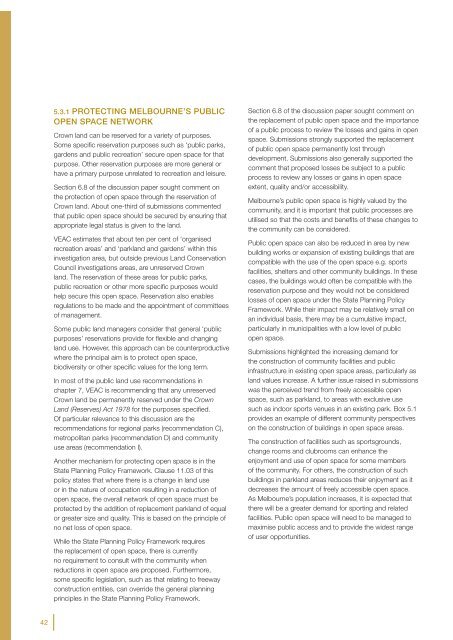Metropolitan Melbourne Investigation - Victorian Environmental ...
Metropolitan Melbourne Investigation - Victorian Environmental ...
Metropolitan Melbourne Investigation - Victorian Environmental ...
Create successful ePaper yourself
Turn your PDF publications into a flip-book with our unique Google optimized e-Paper software.
5.3.1 Protecting <strong>Melbourne</strong>’s public<br />
open space network<br />
Crown land can be reserved for a variety of purposes.<br />
Some specific reservation purposes such as ‘public parks,<br />
gardens and public recreation’ secure open space for that<br />
purpose. Other reservation purposes are more general or<br />
have a primary purpose unrelated to recreation and leisure.<br />
Section 6.8 of the discussion paper sought comment on<br />
the protection of open space through the reservation of<br />
Crown land. About one-third of submissions commented<br />
that public open space should be secured by ensuring that<br />
appropriate legal status is given to the land.<br />
VEAC estimates that about ten per cent of ‘organised<br />
recreation areas’ and ‘parkland and gardens’ within this<br />
investigation area, but outside previous Land Conservation<br />
Council investigations areas, are unreserved Crown<br />
land. The reservation of these areas for public parks,<br />
public recreation or other more specific purposes would<br />
help secure this open space. Reservation also enables<br />
regulations to be made and the appointment of committees<br />
of management.<br />
Some public land managers consider that general ‘public<br />
purposes’ reservations provide for flexible and changing<br />
land use. However, this approach can be counterproductive<br />
where the principal aim is to protect open space,<br />
biodiversity or other specific values for the long term.<br />
In most of the public land use recommendations in<br />
chapter 7, VEAC is recommending that any unreserved<br />
Crown land be permanently reserved under the Crown<br />
Land (Reserves) Act 1978 for the purposes specified.<br />
Of particular relevance to this discussion are the<br />
recommendations for regional parks (recommendation C),<br />
metropolitan parks (recommendation D) and community<br />
use areas (recommendation I).<br />
Another mechanism for protecting open space is in the<br />
State Planning Policy Framework. Clause 11.03 of this<br />
policy states that where there is a change in land use<br />
or in the nature of occupation resulting in a reduction of<br />
open space, the overall network of open space must be<br />
protected by the addition of replacement parkland of equal<br />
or greater size and quality. This is based on the principle of<br />
no net loss of open space.<br />
While the State Planning Policy Framework requires<br />
the replacement of open space, there is currently<br />
no requirement to consult with the community when<br />
reductions in open space are proposed. Furthermore,<br />
some specific legislation, such as that relating to freeway<br />
construction entities, can override the general planning<br />
principles in the State Planning Policy Framework.<br />
Section 6.8 of the discussion paper sought comment on<br />
the replacement of public open space and the importance<br />
of a public process to review the losses and gains in open<br />
space. Submissions strongly supported the replacement<br />
of public open space permanently lost through<br />
development. Submissions also generally supported the<br />
comment that proposed losses be subject to a public<br />
process to review any losses or gains in open space<br />
extent, quality and/or accessibility.<br />
<strong>Melbourne</strong>’s public open space is highly valued by the<br />
community, and it is important that public processes are<br />
utilised so that the costs and benefits of these changes to<br />
the community can be considered.<br />
Public open space can also be reduced in area by new<br />
building works or expansion of existing buildings that are<br />
compatible with the use of the open space e.g. sports<br />
facilities, shelters and other community buildings. In these<br />
cases, the buildings would often be compatible with the<br />
reservation purpose and they would not be considered<br />
losses of open space under the State Planning Policy<br />
Framework. While their impact may be relatively small on<br />
an individual basis, there may be a cumulative impact,<br />
particularly in municipalities with a low level of public<br />
open space.<br />
Submissions highlighted the increasing demand for<br />
the construction of community facilities and public<br />
infrastructure in existing open space areas, particularly as<br />
land values increase. A further issue raised in submissions<br />
was the perceived trend from freely accessible open<br />
space, such as parkland, to areas with exclusive use<br />
such as indoor sports venues in an existing park. Box 5.1<br />
provides an example of different community perspectives<br />
on the construction of buildings in open space areas.<br />
The construction of facilities such as sportsgrounds,<br />
change rooms and clubrooms can enhance the<br />
enjoyment and use of open space for some members<br />
of the community. For others, the construction of such<br />
buildings in parkland areas reduces their enjoyment as it<br />
decreases the amount of freely accessible open space.<br />
As <strong>Melbourne</strong>’s population increases, it is expected that<br />
there will be a greater demand for sporting and related<br />
facilities. Public open space will need to be managed to<br />
maximise public access and to provide the widest range<br />
of user opportunities.<br />
42
















